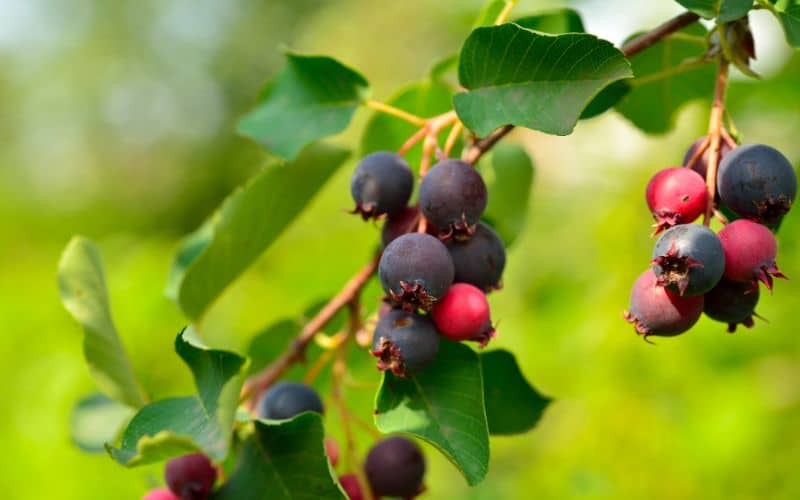
You’ve likely strolled past them on your neighbourhood walks, oblivious to the bounty of goodness they hold. We’re talking about serviceberries, a true gem in Ontario’s urban landscapes and wild forests alike. Serviceberries, also known as Juneberries or Saskatoon berries, are hardy deciduous shrubs that grace our surroundings with their white blossoms in spring and delicious berries come summer.
Why should you care? Well, for starters, these native plants offer more than just beauty to your garden. They’re power-packed with nutritional benefits too! Packed full of antioxidants and vitamins A & C, serviceberries have long been hailed by indigenous communities for their health-enhancing properties.
In addition to being a nutritious snack right off the bush (if you can beat the birds to it!), they add depth of flavour when incorporated into pies or jams. So next time you spot these unassuming bushes while out on a walk around town or in rural areas across Ontario – remember there’s more than meets the eye!
Understanding Serviceberries and Their Growth Cycle
You might’ve seen serviceberries adorning the streets of Ontario, but do you really know what they are? They’re a real gem in the world of berries. Native to North America, these hardy little fruits thrive in our local climate. What’s more, their versatility means they can be used in a whole host of dishes – from pies to preserves.
Now let’s delve into their growth cycle. The journey begins when serviceberry trees bloom with white blossoms between April and May. It’s an incredible sight that signals spring is truly here! Once pollinated by bees or other insects, these flowers give way to small green berries.
As summer rolls around, watch as these green gems ripen into deep red and finally dark purple hues by June or July. That’s your cue – it’s harvest time! But remember: if you’re not quick enough, birds will beat you to it!
Here are some facts about the growth cycle:
- Blossom Time: April-May
- Fruit Development: May-June
- Harvest Time: Late June-July
Wondering how fast serviceberry trees grow? Well, they add 1-2 feet each year until maturity at around 15 years old – quite speedy for a tree!
But don’t think that once winter arrives all activity ceases – far from it! Although dormant during this season (from late October through February), come March there is renewed vigour within the plant as energy reserves are mobilised ready for another season of growth.
Understanding this lifecycle can help gardeners maximise their yield whilst preserving natural ecosystems. So next time you pass by those charming clusters of berries on Ontario streets; take a moment to appreciate them – knowing all about their fascinating journey from flower bud to ripe fruit.
The Health Benefits of Consuming Serviceberries
When you bite into a ripe serviceberry, it’s not just the sweet-tart flavour that’s impressive. This tiny fruit, native to Ontario, is packed full with health benefits.
For starters, serviceberries are loaded with antioxidants. These mighty compounds help combat oxidative stress in your body and ward off chronic diseases like heart disease and cancer. They’re also high in fibre – great for digestion – and low in calories making them an ideal snack if you’re watching your weight.
But let’s talk about vitamin C because these little berries are brimming with it! A cup of fresh serviceberries provides nearly half of your daily recommended intake. Vitamin C aids many bodily functions including healing wounds and maintaining healthy bones and teeth.
Ever heard of anthocyanins? You’ll find plenty in serviceberries. These plant pigments have been linked to lower risk factors for heart disease such as cholesterol levels or blood pressure.
Here’s a quick glance at some nutritional facts:
| Nutrient | Quantity (per 100g) |
|---|---|
| Calories | 48 |
| Protein | 1g |
| Fat | less than 1g |
| Carbohydrates | 12g |
| Vitamin C: Approximately half the daily recommended intake |
Don’t forget minerals either; magnesium, calcium, iron – they’ve all got a place within these nutritious berries too!
So next time you spot those clusters of deep purple-blue fruits hanging from trees around Ontario parks or even growing wild on country roadsides – remember what goodness lies within each one.

Serviceberry Pests and Diseases: A Prevention Guide for Ontario Gardeners
In the lush green landscapes of Ontario, you’ll find serviceberries sprouting their white blooms in spring and juicy berries by summer. But as a gardener, it’s important to know that these attractive shrubs can fall prey to pests and diseases. So here’s your guide on how to keep them at bay.
Firstly, let’s talk about pests. Aphids are tiny insects that suck sap from serviceberry leaves, causing them to curl up or yellow. Regular inspection of your plants is crucial – if you spot a sticky residue on the leaves or ants crawling around (they’re attracted to aphid secretion), chances are you’ve got an aphid issue.
Caterpillars too pose a threat as they feed on the foliage. Often found hiding during daylight hours beneath leaves or bark crevices, they come out at night for their feasting spree! Using biological controls like introducing beneficial insects (think ladybirds) can help manage these pest populations naturally.
Moving onto diseases – Fire blight is one disease that hits serviceberries hard. It’s caused by bacteria which darken branches giving them a ‘burnt’ appearance; hence its name! Early detection is key here – prune infected areas immediately before it spreads further into your plant.
Another common disease plaguing serviceberries is leaf rust fungi causing bright orange spots under leaf surfaces disrupting photosynthesis process ultimately affecting overall growth & berry production!
- Pests
- Aphids
- Caterpillars
- Diseases
- Fire Blight
- Leaf Rust Fungi
Conclusion: Embracing the Versatility of Serviceberries in Ontario
You’ve journeyed through a world full of delightful serviceberries, haven’t you? Now it’s time to wrap up and highlight the key takeaways from this intriguing exploration.
Firstly, let’s not forget how versatile these little gems are. Whether you’re making jams or pies, decorating your garden or just snacking on them fresh off the tree – serviceberries have got you covered! Their versatility extends beyond culinary uses too; they’re a boon for wildlife and an asset to any landscaper’s toolkit.
Secondly, we must appreciate their adaptability. No matter what part of Ontario you call home – be it Ottawa Valley or Niagara Region – there’s room for a serviceberry tree in your life.
And last but not least is their hardiness. It takes some serious grit to withstand our harsh Canadian winters and come out blooming every spring!
Let’s recap:
- Versatile use: culinary delights, landscaping charm
- High adaptability: thrives across different regions
- Winter hardy: resilient against harsh weather conditions
So there we have it! You now know why embracing the wonderful world of serviceberries could be one great decision away. They’re more than just pretty berries; they’re stalwarts that can add value to your property and joy to your life with minimal fuss.
Remember though while they require less maintenance compared to other trees, proper care still plays an important role in ensuring healthy growth over years (yes that includes regular watering during dry spells!).
Embrace these unique characteristics because when all is said and done who wouldn’t want something so remarkably beneficial gracing their gardens? Happy gardening!








